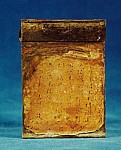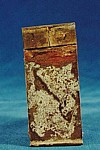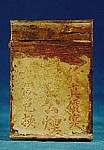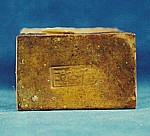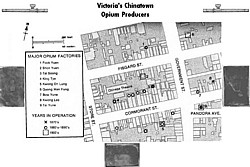|
|
Opium
Opium, though an introduced drug, became a mainstay of Chinese culture rather rapidly. By the time the 19th century rolled around opium was virtually synonymous with the Chinese presence in North America. For upper class Chinese, opium was offered at social gatherings, or as a way to seal business deals. For the lower class Chinese, opium was a way to endure physical labor, or to help themselves fall asleep at night. Many smoked because it was a part of their culture, as it was a temporary escape from feelings of loneliness or alienation, or as a way to help forget the debts they owed to the companies.7 Opium was a fine science, with many different grades available for purchase. These grades ranged from the finest opium, imported from Hong Kong under brand names like Sources of Beauty or Abundant Luck, to literally pipe scrapings. The best opium sold for $9 a can in San Francisco in 18717, while lesser grades would cost much less. Sold in five tael cans(each tael is the equivalent of 1.333 Imperial ounces), the opium was a viscous liquid, not unlike molasses5. Put on a needle, it needed to be cooked until soft before being placed on a pipe and smoked.9
The can at the top of the page is from a brand of opium being produced in Victoria, BC. After the American's banned the production and import of opium in the US after 1880, Canada was the only legal source of opium in North America3. Many companies shifted their production bases to the west coast of Canada in order to stay in business. As the map below suggests, this lead to a rocketing number of factories in Victoria's Chinatown3. The business was so profitable that the provincial government imposed a licensing fee on the factories that was $250 a year in 1886, and $500 a year in 18873. Victoria's Chinatown Opium production remained legal in Canada until July 20, 1908. The ban was brought about by an interesting chain of events. The year before, anti-oriental feelings had reached a peak in British Columbia and a race riot occurred. On September 7, 1907 white agitators, spurred on by labor agitators, the church, and members of the Asiatic exclusion league, attacked Vancouver's Chinatown, breaking into businesses and destroying property. They were eventually stopped when they moved into Japantown, and were driven out by members of that community. In May of 1908, W.L. Mackenzie King, the deputy minister of labor at the time, came to Vancouver to investigate claims for damages from the riots the year before. It was the claims of two opium manufactures for $600 a piece for disrupted business that lead to his realizing that this activity was being condoned. When he return to Ottawa it was his report that led to a federal act that was passed, banning the further import and manufacturing of opium in Canada3. Prior to the ban on opium in Canada, over 90,000 pounds of the stuff would be made or imported into the country each year3. Of this, only 20% was ever consumed by the Chinese. Most of the opium produced and imported in North America would find its way into Patent medicines, consumed by the rest of the nation. Mixed with alcohol and a flavoring, it was called laudanum, and was added in the hopes that heavy consumption of the medicine would lead to a dependency and therefor increased sales of the product7. Of the opium smoked by the Chinese, there was a great deal of items needed to properly smoke the opium. Smoking opium required not only a can of opium and a needle to heat the opium on, but also a pipe and various other tools by which to prepare and process the opium. All of this was carefully designed to make the opium less of a danger to the consumer. A good brand of opium, properly prepared and smoked would not be very addicting to the smoker and would not pose a great danger to their health. It was the cheaper brands of opium that posed a real danger to the consumer, increasing rates of addiction and causing poor health7. The pipe itself was made of bamboo, an item that would not be found in the archaeological record very often. The pipe bowl is another story all together. Made of clay of varying qualities, they ranged in price from cheap to more expensive. As to be expected, the cheaper bowls have been found in mining and railroad camps, while better bowls have been found in Chinatowns and settlements9. The pipe bowl is designed on a pattern that allows for the minimum burning of the opium, and the maximum distillation of it. The opium would be placed on the upper surface of the bowl, and the flame sucked against it. The smoke would be sucked through the bowl and the pipe before being inhaled by the smoker. The pipe bowl and bamboo pipe would remove many of the dangerous chemicals present in the opium, reducing the risk to the smoker. Poor quality opium, literally pipe scrapings, would then prove a high danger to the smoker, containing more of these chemicals7.
|
